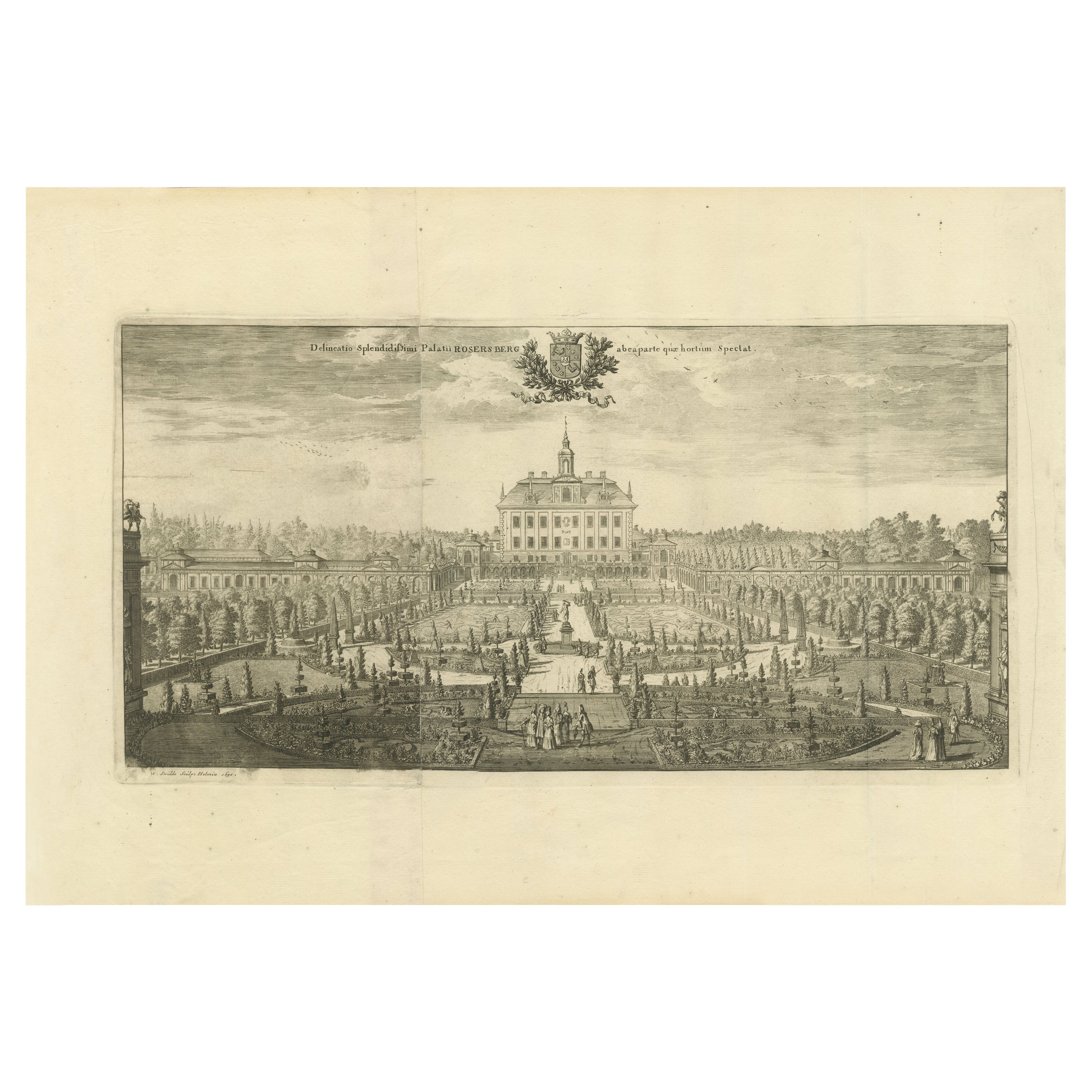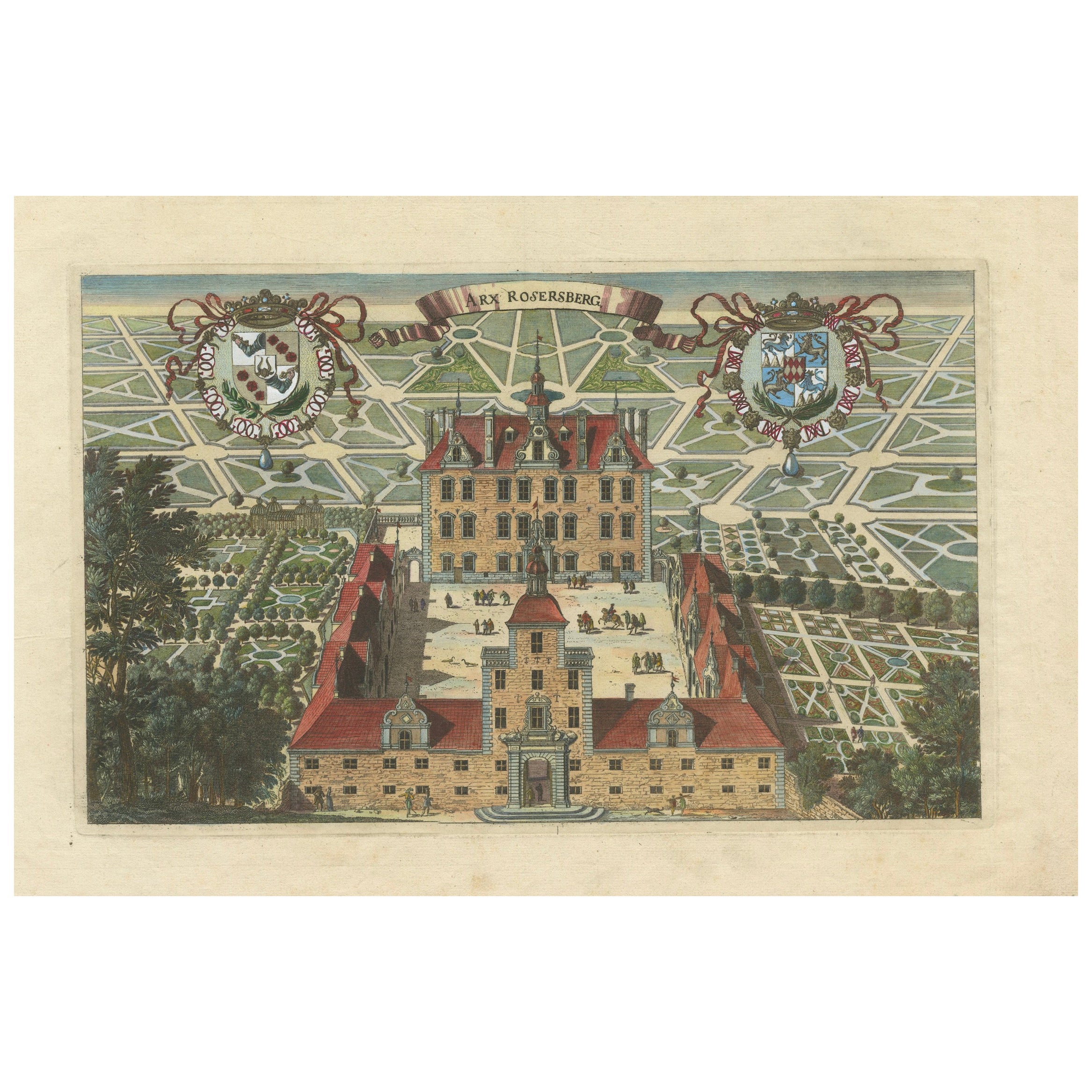Items Similar to Rosersberg Palace and Gardens near Stockholm in the Baroque Splendor of 1695
Want more images or videos?
Request additional images or videos from the seller
1 of 9
Rosersberg Palace and Gardens near Stockholm in the Baroque Splendor of 1695
About the Item
This is a historical etching from "Suecia Antiqua et Hodierna", which translates to "Ancient and Modern Sweden", a large work that includes a collection of engravings collected by Erik Dahlbergh during the late 17th century. This particular etching by Willem Swidde from 1695 showcases Rosersberg Palace and its formal gardens, offering a detailed representation of the palace's architecture and the structured layout of the garden, typical of the baroque style of the era.
Rosersberg Palace, located near Sigtuna and not far from Stockholm, Sweden, was built in the 1630s and has been a part of the Swedish royal heritage. The etching captures the grandeur of the palace at the time when Sweden was a significant European power, reflecting the ambition to document and glorify the nation's cultural and architectural achievements. The formal gardens, as seen in the etching, are meticulously laid out in a symmetrical pattern, which was a common feature in baroque landscape design.
The engraving provides a valuable historical insight into the appearance and surroundings of Rosersberg Palace during the time of its creation. The palace itself remains a well-preserved example of Swedish architecture from that period and is a testament to the ambitions of the Swedish Empire during its era of great power.
More about the engraver:
Willem Swidde (also spelled Swidde or Swiddes) was a Dutch draughtsman and engraver known for his work in Sweden during the late 17th century. His exact birth date is not well-documented, but it is generally accepted that he was active during the latter half of the 1600s until his death in 1697.
Swidde is most renowned for his contributions to Erik Dahlbergh's "Suecia Antiqua et Hodierna," a grand topographical work intended to glorify Sweden, which was a major European power at the time. He was one of the primary engravers for this project, creating a significant portion of the plates.
Swidde moved to Stockholm around 1688. His work for the "Suecia Antiqua et Hodierna" consisted of illustrations based on drawings by Dahlbergh, which he sometimes corrected and improved in collaboration with Dahlbergh. Despite the Swedish focus of his work, Swidde's style was influenced by his Dutch origins and the broader European baroque trends of the time.
His life in Sweden was predominantly dedicated to his work on "Suecia Antiqua et Hodierna." Unfortunately, details about his personal life, training, and early career in the Netherlands are scarce. Swidde's death in Stockholm in 1697 marked the end of a career that had a lasting impact on the visual documentation of Sweden's historical landscapes and architecture.
- Dimensions:Height: 13.12 in (33.3 cm)Width: 21.07 in (53.5 cm)Depth: 0 in (0.02 mm)
- Materials and Techniques:
- Period:1690-1699
- Date of Manufacture:1695
- Condition:Good. Minor soiling. Very clean overall, especially considering its age. Two plates joined with the vertical line visible. A number of creases, mostly outside the image. Please study the images carefully.
- Seller Location:Langweer, NL
- Reference Number:
About the Seller
5.0
Platinum Seller
These expertly vetted sellers are 1stDibs' most experienced sellers and are rated highest by our customers.
Established in 2009
1stDibs seller since 2017
1,929 sales on 1stDibs
Typical response time: <1 hour
- ShippingRetrieving quote...Ships From: Langweer, Netherlands
- Return PolicyA return for this item may be initiated within 14 days of delivery.
More From This SellerView All
- Baroque Grandeur: The Rosersberg Palace Gardens in Swidde's 1695 EngravingLocated in Langweer, NLThe image is an original antique copperplate engraving by Swidde, completed in 1695. The scene is a meticulous depiction of an elegant palace and its formal gardens, rendered in the ...Category
Antique 1690s Prints
MaterialsPaper
- Rosersberg Palace in Sweden: Dual Perspectives by Willem Swidde, circa 1695Located in Langweer, NLTitle: "Rosersberg Palace: Dual Perspectives by Willem Swidde" Description: The featured antique engravings portray Rosersberg Palace in Sweden, captured from two distinct vantage p...Category
Antique Late 17th Century Prints
MaterialsPaper
- Rosersberg Castle and Gardens in the Swedish Baroque Era, 1690Located in Langweer, NLThe engraving is a historical depiction of Rosersberg Castle, a baroque estate in Sweden. These engravings, often created in the 1690s as part of Erik Dahlberg's collection, typicall...Category
Antique 1690s Prints
MaterialsPaper
- The Ekolsund Castle and Gardens in Sweden in Swidde's 1695 EngravingLocated in Langweer, NLThe print is aan original detailed 1695 engraving of Ekolsund Castle in Sweden, crafted by Willem Swidde. The engraving is part of the collection from "Suecia Antiqua et Hodierna," which was a grand work showcasing the estates and landmarks of Sweden through elaborate illustrations. The scene depicted in the engraving is a classic example of the baroque garden architecture style, with geometrically arranged gardens, symmetrical layouts, and an expansive approach leading up to the castle, emphasizing the grandeur and formality of the estate. The meticulous detail in the gardens and the inclusion of figures within the grounds suggest a vibrant and cultured estate life. Ekolsund Castle, located in Enköping Municipality in Uppsala County, Sweden, is a manor house with a rich history dating back to the 14th century. By the 15th century, it was owned by the prominent Bengt Jönsson...Category
Antique 1690s Prints
MaterialsPaper
- Baroque Dignity: Tessin Palace in Stockholm Captured by J. van den Aveelen, 1702Located in Langweer, NLThe engraving provided is a hand-colored work by the artist and engraver, Johannes or Johan van der Aveelen,. He worked on engravings for Erik Dahlbergh’s project, "Suecia Antiqua et Hodierna," which was a grand collection of engravings...Category
Antique Early 1700s Prints
MaterialsPaper
- The Manors of Kärsö and Malmvik near Stockholm in Sweden, by Erik Reitz, ca.1690Located in Langweer, NLThe manors depicted in this original antique engraving, Kärsö and Malmvik, are located in Sweden. The image is a copper engraving from the famous work "Suecia Antiqua et Hodierna," ...Category
Antique 1690s Prints
MaterialsPaper
You May Also Like
- In the Garden of Good and Evil Digital PaintingBy Daria PetrilliLocated in Milan, ITThis Pop-Surrealist digital painting depicts a woman being tempted by a serpent in the Garden of Eden. Instead of an apple, she is holding a broken heart in her hands. The female figure stand out against a lush background of exotic foliage and flowers. Part of a signed, numbered Limited Edition. "Certificate of Authenticity" include. Basswood box frame. Year of Creation: 2015 Edition Number: 1/300 Artist’s Signature: Printed on the Canvas + original signature on Limited Edition Certificate...Category
2010s Italian Modern Paintings
MaterialsCanvas, Wood, Cotton
- Antique Map of the Royal Botanic Garden & Arboretum Kew in London, EnglandLocated in San Diego, CAA very nice antique map of the Royal Botanic Garden & Arboretum in London, England, circa 1880s. The map itself measures 12" x 16" and is professionall...Category
Antique Late 19th Century English Prints
MaterialsPaper
- "The Battle of Bunker's Hill, Near Boston" Engraving by James Mitan, 1801By John TrumbullLocated in Colorado Springs, COThis dramatic Revolutionary War engraving of the Battle of Bunker Hill is after the famous 1785 oil-on-canvas by John Trumbull. Capturing the intensity of the battle, the engraving centers on Major John Small restraining a “lobster-back” from bayoneting Major General Joseph Warren. Warren lies mortally wounded in the midst of chaos around him. In the background, British forces are seen cresting the last defenses of the brave, yet green army of Colonial soldiers. The Battle of Bunker Hill was fought on June 17, 1775, in the early stages of the American Revolutionary War. The battle is named after Bunker Hill in Charlestown, Massachusetts. Although it was the original objective of both the Colonial and British troops, the area was only peripherally involved in the battle. Rather, the majority of the combat took place on the adjacent Breed’s Hill. The battle pitted a more organized British force against a young and inexperienced American militia. Although considered a tactical victory for the British, it came at the cost of considerable casualties, including a large number of officers. The battle demonstrated that the inexperienced American militia was able to stand up to the British army troops in battle. The battle results discouraged the British from any further frontal attacks against well-defended front lines. American casualties were comparatively fewer, although their losses included Gen. Joseph Warren. During the battle, the patriot-turned-painter John Trumbull (1756-1843) was stationed in Roxbury on the far side of Boston, where he could hear the sounds of fighting. In late 1785, Trumbull decided to devote himself to the depiction of Revolutionary War scenes, a series of eight epic pictures. From the beginning, Trumbull intended for the paintings to be later engraved for sale. Trumbull began the oil-on-canvas of The Death of General Warren at the Battle of Bunker’s Hill and The Death of General Montgomery in the Attack of Quebec, in the studio of Benjamin West in London. Bunker’s Hill was completed in March 1786; Trumbull started Attack of Quebec in February 1785 and finished it before he brought it to Paris in 1786. He then started The Declaration of Independence at Thomas Jefferson's house in Paris. As soon as Bunker’s Hill was completed, Trumbull searched for a suitable engraver in London. He was unsuccessful, as many British engravers were nervous about engraving an American battle...Category
Antique Early 1800s English Federal Prints
MaterialsPaper
- Pair of Huge Original Circa 1660 Pierre Mignard '1612-1695' Copper Plate PrintsBy Pierre MignardLocated in GBWe are delighted to offer this exquisite pair of extra large Burr Satinwood framed copper plate prints dating to circa 1660 by the genius that was Pierre Mignard...Category
Antique 1660s English Charles II Decorative Art
MaterialsPaper
- Art Deco Embossed Lithograph on Celluloid, Panther and Tamer in Palace, 1920'sLocated in Petaluma, CAThis most unique piece of artwork is an incredible example of what could be done using celluloid. I have bought and sold some smaller pieces of antique advertising where celluloid wa...Category
Vintage 1920s American Art Deco Prints
MaterialsOther
- Original 1750s Antique Botanical Print of Echinops - The Gardener’s DictionaryLocated in Montréal, CAEchinops. Upper Right: Pl. CXXX. Lower Left: R. Lancake delin. Lower Center: Publish'd according to Act of Parliament by P. Miller Novem. the 30th 1756. Lower Right: I. S. Miller Scu...Category
Antique Mid-18th Century British Prints
MaterialsPaper





